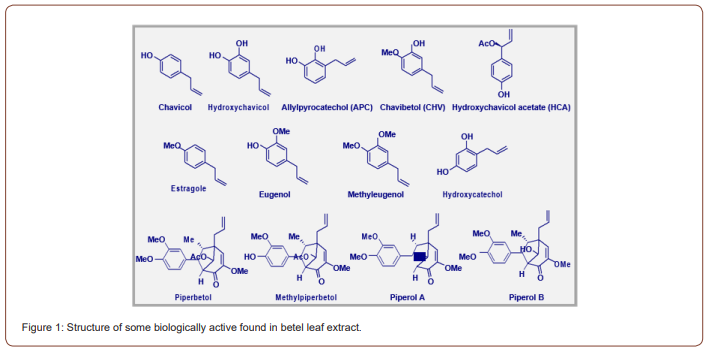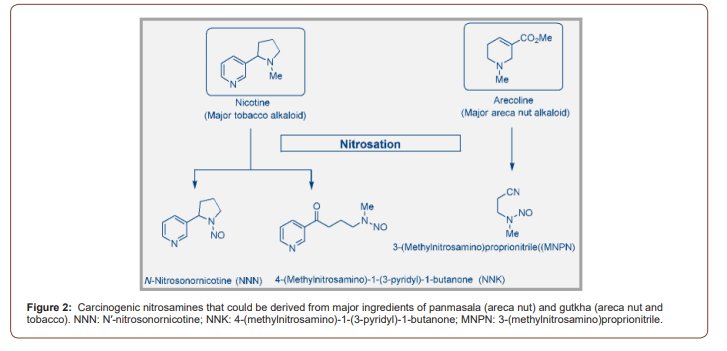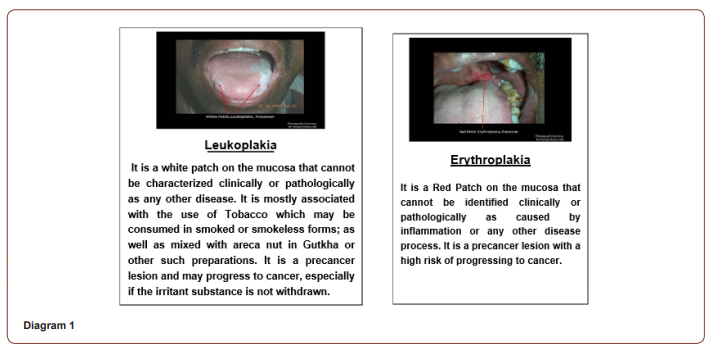 Research Article
Research Article
Chemistry behind the Betel Leaves and Betel Quid: Their Health Benefits and Adverse Health Effect-a Review
Moumita Nath1 and Pradip Debnath2*
1Department of Forestry and Biodiversity, Tripura University, India
2Department of Chemistry, Maharaja Bir Bikram College, India
Dr. Pradip Debnath, Department of Chemistry, Maharaja Bir Bikram College, Agartala, Tripura 799004, India
Received Date: June 11, 2021; Published Date: July 16, 2021
Abstract
Piper betle leaves have been used in Indian and Chinese folk medicine for centuries and is well known for its extensive use in Ayurvedic medicine. Recently, it has been used as a chemo-preventive agent because of its anti-oxidant activity. Several biologically active compounds from P. betle have potential for use as medicines, neutraceuticals and industrial compounds. Consumption of betel leaf is usually in the form of betel quid which consists of areca nut, lime and some spices with or without tobacco. Long term consumption of betel quid with tobacco is known to cause adverse health effects, mainly carcinomas. In addition to oral cancer it is also known to induce chromosomal aberrations and tumours in the pharynx and oesophagus. However, consumption of betel leaf alone does not induce cancer and has invaluable health benefits due to its tremendous medicinal properties. Phenol-rich leaves of P. betle show high antioxidant activities and because of its anti-oxidant properties, it has been used as a chemopreventive agent. Its oil is used as an industrial raw material for manufacturing of medicines, perfumes, mouth fresheners, tonics, food additives etc. The leaves are nutritive and contain anti-carcinogens showing promise for manufacturing of a blood cancer drug. It is also playing a vital role in various ceremonies and auspicious occasions as an indicator of goodness. Since the traditional use of P. betle involves chewing, it offers possibilities of use in drug delivery through buccal mucosa bypassing the gastric route.
Keywords: Betel leaves; Betel quid; Chemical composition; Medicinal properties; Health benefits and Adverse health effect
Introduction
Medicinal plants are of proven value as potential therapeutics with the increase of resistant pathogens to commonly used antibiotics and the emergence of new infectious diseases. Human dependence on plants as source of medicine dates back to prehistoric times. Even now, more than three-fourths of the world’s population relies mainly on plants and plant extracts for healthcare. Piper betle L. is one of the important plants in the Asiatic region which ranks second to coffee and tea in terms of daily consumption. Piper betle L., is an evergreen perennial creeper belonging to family Piperaceae and is known to possess numerous medicinal properties. Piper betle is a plant with known ethno-medicinal properties and its use in India, Indonesia and other countries of the Indo-China region like Malaysia, Vietnam, Laos, Kampuchea, Thailand, Myanmar, Singapore, and Bangladesh is well known. It is a mild stimulant and has a lot of medicinal properties. Betel leaves have been used in Indian and Chinese folk medicine for centuries and is also well known for its extensive use in Ayurvedic medicine. Use of betel leaves are known for its curative properties such as: to reduce/prevent body odour and bad breath, throat and lung problems, cough prevention and healing, to prevent itching caused by fungus and internal/ external bacteria [1]. The leaf extract, fractions and purified compounds are found to exhibit several biological activities including oral hygiene, anti-diabetic, cardiovascular, anti-inflammatory, anti- ulcer, anti-cancer, hepato-protective, and anti-infective etc [2,3]. Many patents were also awarded for some of the biological activities like anti-inflammatory, [4] anti-cancer [5] and immunomodulatory [6] associated with leaf extracts and purified compounds. The betel leaves are also credited with wound healing, digestive, and pancreatic lipase stimulant activities in the traditional medicine [7]. The active compounds isolated from leaf and other parts are hydroxychavicol, hydroxylchavicol acetate, allylpyrocatechol, chavibetol, piperbetol, methylpiperbetol, piperol A and piperol B. Phenol-rich leaves of P. betle show high antioxidant activities. The Essential oil isolated from the leaves is supposed to be useful in treating respiratory catarrhs and as an anti-septic [8]. Its leaves, with strong pungent and aromatic flavour, are widely consumed as mouth freshener. On the other hand, consumption of betel quid with tobacco poses serious health hazard. Long term consumption of betel quid with tobacco is known to cause adverse health effects, mainly carcinomas. In addition to oral cancer it is also known to induce chromosomal aberrations and tumours in the pharynx and oesophagus. Betel leaf is the most valuable home remedy for common illness. Since the traditional use of P. betle involves chewing, it offers possibilities of use in drug delivery through buccal mucosa bypassing the gastric route. This review presents a systematic overview on chemical compositions, health benefits of betel leaf and the health effect of betel quid.
Cultivation of Betel Leaf
Betel leaf is widely grown in the tropical humid climate of South East Asia and thus, cultivated in most of South and Southeast Asia. In India, it is widely cultivated in Tamil Nadu, Madhya Pradesh, West Bengal, Orissa, Maharashtra and Uttar Pradesh. Leaves 10-20 cm long, broadly ovate, slightly cordate and often unequal at the base, shortly acuminate, glabrous, glaucous on both sides, bright green and yellowish, petiole stout 2.0-2.5 cm long. Male spikes cylindrical dense. Female spikes 2.5-5.0 cm long, pendulous. Fruits rarely produced, often sunk in the fleshy spike, forming nodule-like structures [9]. For the proper growth of betel requires high land and especially fertile soil; waterlogged, saline and alkaline soils are not suitable for its cultivation. Proper shade and irrigation are essential for the successful cultivation of this crop. In Bangladesh, farmers called Barui prepare a garden called a Barouj in which betel is grown. The Barouj is fenced with bamboo sticks and coconut leaves. The soil is flowed into furrows of 10 to 15 meters length, 75 centimetres in width and 75 centimetres depth. The creeper cuttings are planted after proper dressing in the months of May and June at the beginning of the monsoon season. The leaves of the plant become ready for plucking after one year of growth and the production of the Barouj lasts for several years from the date of planting. Betel needs constantly moist soil, but there should not be excessive moisture. In 3 to 6 months the vines reach 150 to 180 centimetres in height and they will branch. The harvested leaves are used both for domestic consumption and for export to other parts of Asia, the Middle East, Europe, and the United States. Betel is an important part of the economy in rural India as well as Bangladesh.
Consumption of Betel Leaf
Betel leaf is mostly consumed in Asia and elsewhere in the world by some Asian emigrants, as betel quid or paan, with or without tobacco. It has an addictive psycho-stimulating and euphoria-inducing formulation with adverse health effects. The deep green heart shaped leaves of betel vine are popularly known as Paan in India. An extensive research monograph by the World Health Organization in 2004 reports that betel leaf is consumed in South East Asian community worldwide, predominantly as a betel quid or paan. The betel quid contains betel leaf, areca nut and slaked lime, and may contain tobacoo. Other substances are often added to the betel quid, in particular spices, such as cardamom, saffron, cloves, aniseed, turmeric, mustard or sweeteners according to local preferences. The betel quid is thus a mixture of substances and betel leaf is not consumed alone. For a predominant majority, the paan usually contains the betel leaf with two basic ingredients, either tobacco, or areca nut or both, in row or any processed form. There is archaeological evidence that the betel leaves have been chewed along with the areca nut since very ancient times. In most countries the mixture of both has a ceremonial and highly symbolic value. In India, Burma, Nepal, Sri Lanka and other part of South Asia and Southeast Asia, the leaves are chewed together in a wrapped package along with the areca nut which, by association, is often inaccurately called the ‘betel nut’ and mineral slaked lime (calcium hydroxide). The lime acts to keep the active ingredient in its freebase or alkaline form, thus enabling it to enter the bloodstream via sublingual absorption. The areca nut contains the alkaloid arecoline, which promotes salivation, and is itself a stimulant. In India, the betel and areca play an important role in Indian culture, especially among Hindus. Many traditional ceremonies governing the lives of Hindus use betel and areca. Moreover, offering betel morsel (pan-supari) to guests in Indian subcontinent is a common courtesy. The betel and areca also play an important role in Vietnamese culture. The betel leaves and areca nuts are used ceremonially in traditional Indian and Vietnamese weddings. The lime must be purchased and processed from corals, especially the fast-growing stag horn corals of genus Acropora. Chewing betel quid to give fragrance to mouth.
Composition
The specific spicy burning taste of betel leaf is derived from the presence of volatile oil consisting of phenols and terpenes etc. The taste and aroma depends on the presence and proportion of the various components in the oil which are vary markedly among the cultivars and makes them differ in aroma and taste. An analysis of the betel leaf shows that it consist of moisture (85.4%), protein (3.1%), fat (0.8%), minerals (2.3%) including Iron and Aluminium, Fiber (2.3%), and Carbohydrates (6.1%) per 100 grams.3 Its minerals and vitamin contents are Calcium, Riboflavin, Carotene, Niacin, Thiamine, Vitamin B and C. Its calorific value is 44. Recent studies have shown that betel leaves contain tannins, sugar and diastases and an essential oil. The essential oil is a light-yellow liquid of aromatic odor and sharp burning in taste. It contains a phenol called chavicol which has powerful antiseptic properties. The alkaloid arakene has properties resembling cocaine in some respects. The active ingredients of betel oil, which is obtained from the leaves, are primarily a class of allylbenzene. Though particular emphasis has been placed on chavibetol (betel phenol, 3-hydroxy-4-methoxyallylbenzene), it also contains chavicol (p-allyl phenol), estragole (p-allyl anisole, 4-methoxy allylbenzene), eugenol (allylguaiacol, 4-hydroxy-3-methoxy allylbenzene, 2-methoxy-4-allylphenol), methyl eugenol (eugenol methyl ether, 3,4-dimethoxy allylbenzene) and hydroxycatechol (2,4-dihydroxy allylbenzene) [2,10]. Several terpenes and terpenoids are present in the betel oil as well. There are two monoterpenes such as p-cymene and terpinene, and two monoterpenoids, eucalyptol and carvacrol. Additionally, there are two sesquiterpenes, cadinene and caryophyllene. They also contain significant amounts of all essential amino acids except lycine, histidine and arginine. Large concentrations of asparagines are present while glycine and proline occur in good amount. Essential oil of leaf gives it the aromatic flavour. Importantly, β-sitosterol is present in the root [11] (Figure 1).



Antimicrobial Activity: Nair and Chanda (2008), have studied the aqueous and methanol extract of the leaves of Terminalia catappa L., Manilkara zapota L. and Piper betel L., for antibacterial activity against 10 Gram positive and 12 Gram negative bacteria [13]. In this study, Piperacillin and gentamicin were used as standards for antibacterial assay, while fluconazole was used as standard for antifungal assay. The three plants showed different degree of activity against the microorganisms investigated and observed that the most active antimicrobial plant was Piper betel among this three trees. The methanolic extract was considerably more effective than aqueous extract in inhibiting the investigated microbial strains.
Antihistaminic activity: Hajare et al., (2011), were evaluated Piper betel Linn. leaves for its antihistaminic activity [14]. In the study, the pharmacological evaluation of ethanolic extract and essential oil extract of leaves of P. betel Linn. has been done for their antihistaminic activity on guinea pig. Chloropheniramine maleate was used as a standard drug. In isolated guinea pig tracheal chain preparation, there was a right side shift of dose response curve (DRC) of histamine. Moreover, extracts of P. betel disturbed histamine aerosol induce bronchoconstriction in whole guinea pig, where essential oil was more effective comparatively to ethanolic extract. Thus, they concluded that ethanolic extract and essential oil of P. betel Linn possess antihistaminic activity.
Introduction
Introduction
Introduction
Introduction
Introduction
References
- MS Sigman, KC Harper, EN Bess, A Milo (2016) Accounts of Chemical Research 49: 1292-1301.
- FD Toste, MS Sigman, SJ Miller (2017) Accounts of Chemical Research 50: 609-615.
- CB Santiago, JY Guo, MS Sigman (2018) Chemical Science 9: 2398-2412.
- J Li, S Grosslight, SJ Miller, MS Sigman, FD Toste (2019) ACS Catalysis 9: 9794-9799.
- Y Kwon, J Li, JP Reid, JM Crawford, R Jacob, et al. (2019) Journal of the American Chemical Society 141: 6698-6705.
- S Zhao, T Gensch, B Murray, ZL Niemeyer, MS Sigman, et al. (2018) Science 362: 670.
- J Miró, T Gensch, M Ellwart, SJ Han, HH Lin, et al. (2020) Journal of the American Chemical Society 142: 6390-6399.
- JP Reid, M Hu, S Ito, B Huang, CM Hong, et al. (2020) Chemical Science 11: 6450-6456.
- JP Reid, RSJ Proctor, MS Sigman, RJ Phipps (2019) Journal of the American Chemical Society 141: 19178-19185.
- Y Hwang, H Jung, E Lee, D Kim, S Chang (2020) Journal of the American Chemical Society 142: 8880-8889.
- DP Hickey, C Sandford, Z Rhodes, T Gensch, LR Fries, et al. (2019) Journal of the American Chemical Society 141: 1382-1392.
- T Tang, C Sandford, SD Minteer, MS Sigman (2021) Chemical Science 12: 4771-4778.
-
Shashank Krishna R, Pradeep Ilayaperumal. Mini Review on Multivariate Linear Regression for Homogeneous Catalysis. 1(5): 2021. ICBC. MS.ID.000521.
-
Multivariate, Linear, Regression, Homogeneous, Catalysis, Multivariate Linear Regression (MLR); Selectivity prediction; Turn-over-frequency; Conformational analyses; Mechanistic analysis; DFT calculations.
-

This work is licensed under a Creative Commons Attribution-NonCommercial 4.0 International License.






